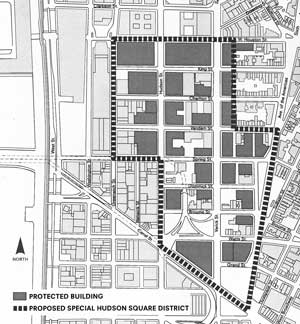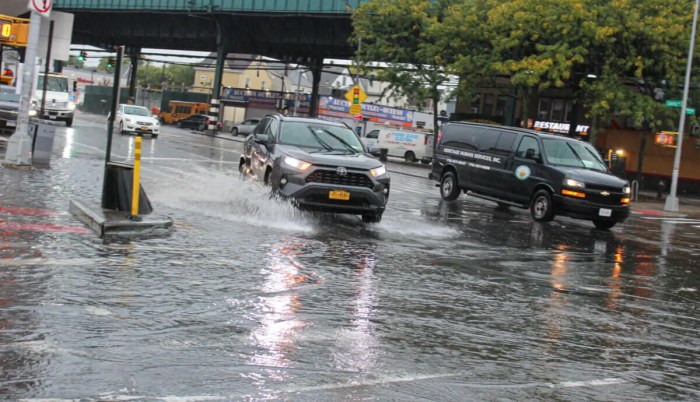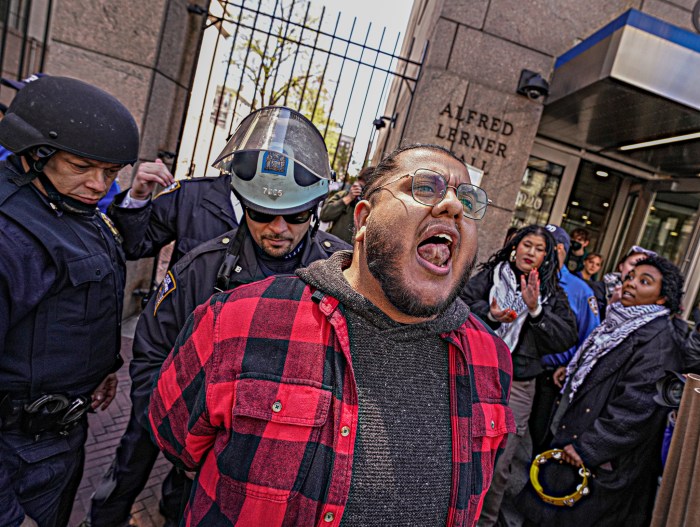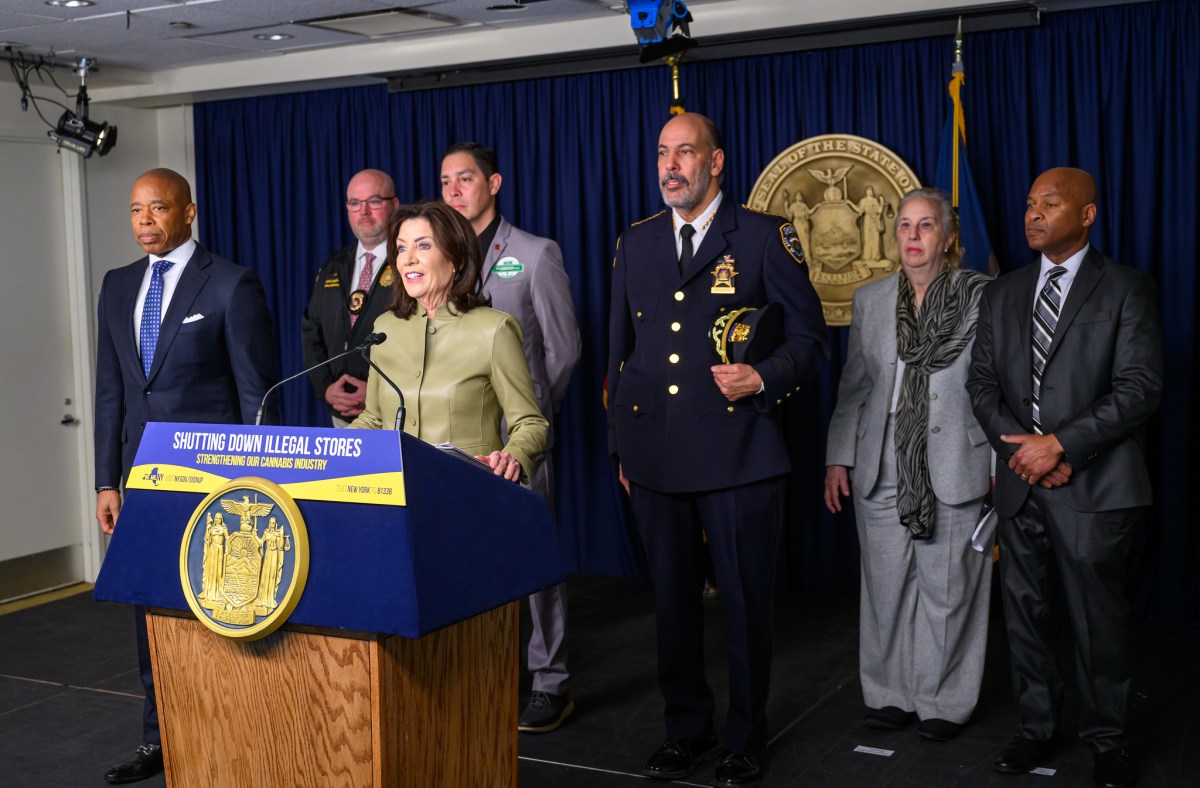
BY LINCOLN ANDERSON | Supporters and opponents of a rezoning for Hudson Square turned out last Thursday to air their views at a town hall meeting held by Community Board 2.
The meeting was part of C.B. 2’s role under the city’s seven-month-long ULURP, or Uniform Land Use Review Procedure, required for rezonings and other projects of significant scope.
The proposed rezoning area is roughly bounded by Canal St. on the south; Hudson and Greenwich Sts. on the west; Houston St. on the north; and Sixth Ave. on the east.
Trinity Real Estate, the area’s major property holder, is proposing the rezoning. Carl Weisbrod, a consultant for Trinity, presented the plan, laying out its key points. These include adding height limits where none currently exist, increasing the area’s residential population and, in turn, its retail options, and generally making it more of a 24/7 neighborhood.
Right now, Weisbrod said, Hudson Square is dominated by hotels, which draw a transient population and taxis, crowding the streets.
Hotels are “sterile,” he said, lacking ground-floor retail to enliven the street.
Currently, there are no restrictions on demolishing the area’s trademark old warehouse buildings, he added. And having no height limits produced the 450-foot-tall Trump Soho condo-hotel, at Spring and Varick Sts., he noted.
The residential occupancy in Hudson Square is now 4 percent, he said, adding that rezoning the area to allow residential use would boost that to 25 percent, assuming the area’s “maximum build-out.”
Under the rezoning, if commercial buildings of more than 70,000 square feet are demolished, the replacement would have to include a 1-for-1 replacement of commercial space, which Weisbrod called a “very strong disincentive” to demolition. Smaller buildings, however, would be ripe for razing for new residential projects.
Gregg Pasquarelli of SHoP Architects, which is assisting Trinity on the rezoning, said the idea is for new projects to have high street walls, “keeping the character and feeling” of Hudson Square.
Trinity is proposing 320-foot height caps for new construction on wide streets, with an F.A.R. (floor area ratio) of 10 for nonresidential buildings. A bonus of 2 F.A.R. for adding a plaza or atrium would be eliminated. The residential F.A.R. would be 9, but bonusable up to 12 by including affordable housing; this formula would also apply to mixed-use buildings.
At least 50 percent of new buildings’ ground-floor street frontage would have to be filled by retail uses to add life to the streets.
On narrow streets, building heights would be capped at 185 feet.
However, at Duarte Square, which is a Trinity-owned development site at Canal St. and Sixth Ave., Trinity is proposing to construct a 430-foot-tall residential building, with a 444-seat public elementary school in its base. Pascarelli said this spot is “different,” since it’s surrounded by broad streets and is near subway stations and the Holland Tunnel. If the rezoning is approved, this building could be built in a year or two, Weisbrod said. Trinity is required to include a public park in the project.
Weisbrod said the rezoning plan is the product of years of work and is “thoughtful and balanced.”
Tobi Bergman, a C.B. 2 member, asked where the height cap of 320 feet came from. Pasquarelli gave a rather long explanation, saying it came from the Department of City Planning, and Bergman said he didn’t think his fellow board members would be satisfied with that answer.
Weisbrod said another goal would be to see if a connection from Hudson Square to Hudson River Park at Spring St. could be made, but that the state Department of Transportation would need to O.K. it. Currently, a crosswalk to the park is located just a block south of there at Canal St.
Big-box stores of more than 10,000 square feet would be forbidden, except for a supermarket, which the community wants, Weisbrod added.
As for a school not being included in Trinity’s hoped-for building at Duarte Square, Weisbrod said that possibility would be “extremely remote.”
Phil Mouquinho, a lifelong area resident who has operated P.J. Charlton restaurant on Greenwich St. for decades, said he likes the rezoning scheme.
“The Sanitation garage that is on Spring St. would not be there if we had a stronger residential community,” he said.
Also favoring the rezoning was the 20-year-old HERE theater at 145 Sixth Ave.
“For an organization like ours, it’s important to have supporters in the neighborhood,” said the theater’s director, Kristin Martin, in a statement read by a HERE staffer.
But Andrew Berman, executive director of the Greenwich Village Society for Historic Preservation, said while G.V.S.H.P. thinks a rezoning is needed, the proposed height caps are too high. Also, he said, the rezoning would put development pressure on the unlandmarked portion of the proposed South Village Historic District, so that area must be landmarked quickly.
Hudson Square “is going to become a bustling, attractive, hot area that’s going to spill over to the South Village,” he warned.
Jacques Torres, who has a chocolate store at Hudson and King Sts., said a similar rezoning was done in DUMBO, where he has another store, and the neighborhood character there remained the same.
“There’s not enough residential for businesses to succeed,” he said of Hudson Square.
Jerry Gottesman of Edison Properties, which owns Manhattan Mini Storage and Edison Park Fast, said his company has issues with the rezoning, chalking it up to its being a “private rezoning” being pushed by Trinity, as opposed to coming from City Planning.
Anthony Borelli, Edison’s vice president for planning and real estate, later said they feel, for example, the requirement for 50 percent retail along the ground floor on Dominick St. — where Edison has a parking lot between Varick and Hudson Sts. — doesn’t make sense since this small, two-block-long street will “never be a retail corridor.” Also, because the parking-lot block is narrower than average from Dominick St. to Spring St., it won’t be possible for them to build two quality residential buildings there, one on each side of the lot. Instead, they’d prefer to build one good building, and create a public park on Dominick St., Borelli explained.
Objecting to the rezoning even more strongly was John Sore of Shalimar Management, which owns the empty lot at 100 Varick St., between Broome and Watts Sts. Shalimar hoped to build a hotel there, but now it won’t be allowed under the rezoning. Also, Sore objected that Trinity plans to include this block in so-called “Subdistrict B,” a lower-density area, where heights will be capped at 120 feet, while Trinity’s own Duarte Square project will be in the taller “Subdistrict A.” The F.A.R. for 100 Varick St. would be only 5.4, with a 1.8 F.A.R. bonus for including affordable housing.
“Two blocks to the north is the Trump Soho, and two blocks to the south is the building that Trinity wants to build,” Sore said indignantly, saying Trinity would unfairly shave Shalimar’s development rights.
Mary Ann Arisman, co-chairperson of the St. Luke’s Place Block Association, said of the proposed height caps, “It’s just too high. It would turn the neighborhood into something resembling Midtown. We urge the community board to protect what is most important to our neighborhood — the low scale.”
Zack Winestine of the Greenwich Village Community Task Force, while saying he approved ending “the hotel abuses” in Hudson Square, said he was worried about having to fill all those retail spaces under the rezoning.
“We’re gonna get banks, we’re gonna get drug stores, we’re gonna get chains unless steps are taken,” he warned.
Mindy Goodfriend, who owns a fairly small, L-shaped building at the southeast corner of Spring and Hudson Sts., said she could see the building becoming “very charming as residential.”
David Reck, former chairperson of C.B. 2’s Land Use Committee, noted he pushed for rezoning the first section of Hudson Square in 2003. Of the current rezoning effort, he said more people are behind it than just Trinity.
“Over all, the vast majority of people who are in Hudson Square favor this rezoning,” he said, adding, “The changes that are going on in Hudson Square are inevitable.”
Board 2’s Hudson Square Working Group will have a meeting on the proposed rezoning on Wed., Sept. 19, at 6:30 p.m. at the Fire Museum, 278 Spring St., third floor.

















